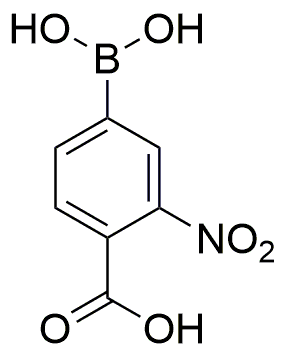4-Carboxy-3-nitrophenylboronic acid is widely utilized in research focused on:
- Drug Development: This compound serves as a crucial intermediate in the synthesis of various pharmaceuticals, particularly in the development of targeted cancer therapies that utilize boron-containing compounds for enhanced efficacy.
- Bioconjugation: It is employed in bioconjugation techniques, allowing researchers to attach biomolecules to surfaces or other molecules, which is vital in creating targeted drug delivery systems and diagnostic tools.
- Organic Electronics: The compound plays a significant role in the fabrication of organic electronic devices, such as organic light-emitting diodes (OLEDs), due to its unique electronic properties that enhance device performance.
- Environmental Monitoring: It is used in the development of sensors for detecting environmental pollutants, particularly in water quality testing, where its sensitivity to specific contaminants is advantageous.
- Chemical Research: This compound is valuable in synthetic organic chemistry for creating complex molecules, providing a versatile tool for researchers looking to explore new chemical pathways and reactions.
Informations générales
Propriétés
Sécurité et réglementation
Applications
4-Carboxy-3-nitrophenylboronic acid is widely utilized in research focused on:
- Drug Development: This compound serves as a crucial intermediate in the synthesis of various pharmaceuticals, particularly in the development of targeted cancer therapies that utilize boron-containing compounds for enhanced efficacy.
- Bioconjugation: It is employed in bioconjugation techniques, allowing researchers to attach biomolecules to surfaces or other molecules, which is vital in creating targeted drug delivery systems and diagnostic tools.
- Organic Electronics: The compound plays a significant role in the fabrication of organic electronic devices, such as organic light-emitting diodes (OLEDs), due to its unique electronic properties that enhance device performance.
- Environmental Monitoring: It is used in the development of sensors for detecting environmental pollutants, particularly in water quality testing, where its sensitivity to specific contaminants is advantageous.
- Chemical Research: This compound is valuable in synthetic organic chemistry for creating complex molecules, providing a versatile tool for researchers looking to explore new chemical pathways and reactions.
Documents
Fiches de données de sécurité (FDS)
La FDS fournit des informations de sécurité complètes sur la manipulation, le stockage et l’élimination du produit.
Spécifications du produit (PS)
Le PS fournit une description complète des propriétés du produit, notamment sa composition chimique, son état physique, sa pureté et les exigences de stockage. Il détaille également les plages de qualité acceptables et les applications prévues du produit.
Certificats d'analyse (COA)
Recherchez des certificats d'analyse (COA) en saisissant le numéro de lot du produit. Les numéros de lot et de lot se trouvent sur l'étiquette d'un produit, après les mots « Lot » ou « Lot de fabrication ».
Numéro de catalogue
Numéro de lot/série
Certificats d'origine (COO)
Ce certificat d'exploitation confirme le pays dans lequel le produit a été fabriqué, et détaille également les matériaux et composants utilisés et s'il est issu de sources naturelles, synthétiques ou autres sources spécifiques. Ce certificat peut être requis pour les douanes, le commerce et la conformité réglementaire.
Numéro de catalogue
Numéro de lot/série
Fiches de données de sécurité (FDS)
La FDS fournit des informations de sécurité complètes sur la manipulation, le stockage et l’élimination du produit.
DownloadSpécifications du produit (PS)
Le PS fournit une description complète des propriétés du produit, notamment sa composition chimique, son état physique, sa pureté et les exigences de stockage. Il détaille également les plages de qualité acceptables et les applications prévues du produit.
DownloadCertificats d'analyse (COA)
Recherchez des certificats d'analyse (COA) en saisissant le numéro de lot du produit. Les numéros de lot et de lot se trouvent sur l'étiquette d'un produit, après les mots « Lot » ou « Lot de fabrication ».
Numéro de catalogue
Numéro de lot/série
Certificats d'origine (COO)
Ce certificat d'exploitation confirme le pays dans lequel le produit a été fabriqué, et détaille également les matériaux et composants utilisés et s'il est issu de sources naturelles, synthétiques ou autres sources spécifiques. Ce certificat peut être requis pour les douanes, le commerce et la conformité réglementaire.


